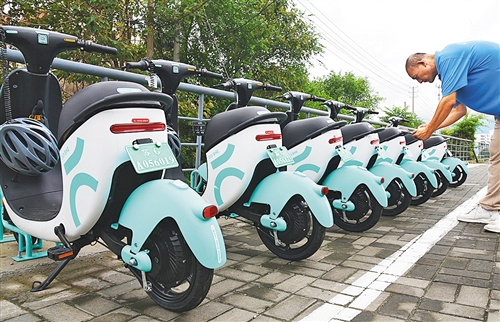
On September 1, the first phase of the first batch of shared electric vehicles with piles in Lianyungang City, Jiangsu Province was officially put into operation. In this project, 55 shared electric vehicle stations were built, and the first batch of 500 shared electric vehicles were put into use. Photo by Geng Yuhe (Zhongjing Vision)
Recently, the Environmental Development Center of the Ministry of Ecology and Environment and the Central Joint Certification Center released the "Report on Pollution Reduction and Carbon Reduction of Shared Cycling" (hereinafter referred to as the "Report"), which shows that as more and more cities create conditions to encourage cycling and introduce emerging modes of travel, shared motorcycles are welcomed by the public. In the past year, the number of users sharing motorcycles has increased by more than four times compared with the previous year, and users who use high-carbon travel have joined the ranks of low-carbon travel. Affected by this, the shared cycling industry has also ushered in a new opportunity period.
The data shows that China’s transportation carbon emissions account for 15% of the national terminal carbon emissions. As an urgent need for urban travel, the growing number of two-wheeled electric vehicles has become the main option to achieve the goal of "double carbon".
According to "China Mobile Source Environmental Management Annual Report (2021)" issued by the Ministry of Ecology and Environment, automobiles are the main contributors to the total emission of pollutants. Bike-sharing and motorcycles have become a new way to build a low-carbon and efficient transportation system and reduce urban pollutant emissions.
Bike-sharing and motorcycles are one of the important ways for the general public to participate in achieving "carbon neutrality". During the "Fourteenth Five-Year Plan" period, China’s ecological environment protection has entered a new stage of coordinated management of pollution reduction and carbon reduction. More and more people choose cycling as their main mode of travel. In addition, more cities introduce shared motorcycles to reduce high-carbon travel such as private cars, and green travel is leading the new lifestyle and helping to reduce pollution and carbon.
According to statistics, the carbon emissions of cars are 16 times that of shared motorcycles. In the trip of sharing motorcycles, more than 31% of trips have replaced high-carbon trips dominated by cars. According to the report, since the operation, the bicycle and motorcycle users of Meituan have reduced the carbon dioxide emissions by 1.187 million tons, which is equivalent to reducing the carbon dioxide emissions of 270,000 private cars for one year.
"Shared travel can achieve double carbon reduction in the manufacturing industry chain and product use." Hu Qianghong, senior vice president of Hellobike, said that Hello is now cooperating with upstream and downstream parts and vehicle manufacturers to build a green industrial chain. Taking a bike-sharing as an example, it is estimated that during the whole life cycle of production, transportation and scrapping, about 76 kilograms of carbon dioxide emissions will be generated. However, during the service life, the average riding distance will exceed 4,000 kilometers, which is estimated to reduce carbon emissions by about 105 kilograms, which can make great contributions to the comprehensive carbon emission reduction of the entire transportation sector.
Under the goal of "double carbon", with the recent announcement of a new round of low-carbon pilot cities, urban carbon reduction may become a new battlefield for local competitiveness.
In February this year, the Central Committee of the Communist Party of China and the State Council issued the Outline of National Comprehensive Three-dimensional Traffic Network Planning, which pointed out that it is necessary to develop shared traffic in an orderly manner, strengthen the construction of slow traffic systems such as walking and cycling in cities, rationally allocate parking facilities, carry out sidewalk purification actions, build bicycle lanes according to local conditions, and encourage the public to travel green.
Accelerating the construction of two-rotation power facilities will become a powerful means for the future development of science and technology, low carbon and green in cities. Hu Yang, senior manager of the charging and traveling department of State Grid Electric Vehicle Service Co., Ltd., said that the two-wheel charging and replacing facilities can be used as a supplement and powerful extension of new energy vehicle facilities. "Urban two-wheeled electric vehicle users not only use two-wheeled trips, but also owners of private cars and new energy vehicles. How to coordinate the development of upstream and downstream related enterprises in the industrial ecological circle and coordinate around the improvement of the quality of green travel services for the masses is worthy of accelerated and collaborative exploration."
"Compared with the four-wheeled new energy vehicle power exchange facilities, the two-wheeled power exchange field has a better scale development effect due to the huge volume of electric bicycles. At the same time, the two-wheeled lithium battery is small in size, light in weight and cheap in price. Compared with the four-wheeled automobile, the operating cost and construction cost have great advantages in network development, and it can truly land in the city, resulting in the unification of economic benefits, commercial benefits and social benefits. " Zhang Haitao, director of committee of 100 Smart Travel Department of China Electric Vehicle, said.
Liu Hongxia, general manager of Tailing’s new business unit, thinks that because the two-rotation electricity business can’t compete with the four-rotation electricity industry in terms of volume, the industry or local policies still lack clear industrial policy guidance, which is not conducive to the optimal allocation of social resources in the medium and long term. The city’s two-shift electricity service needs the integrated operation of "vehicle+electricity+cabinet", and it is necessary to speed up the establishment of multi-party unified standards for complete vehicles, battery enterprises and power exchange service platforms.